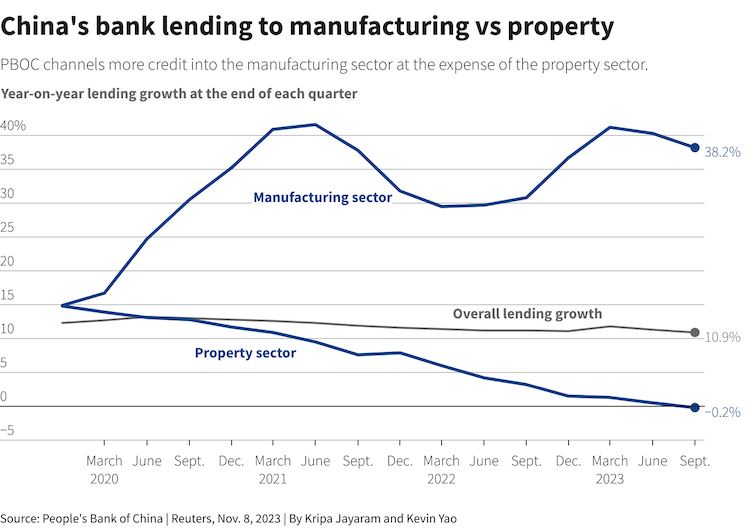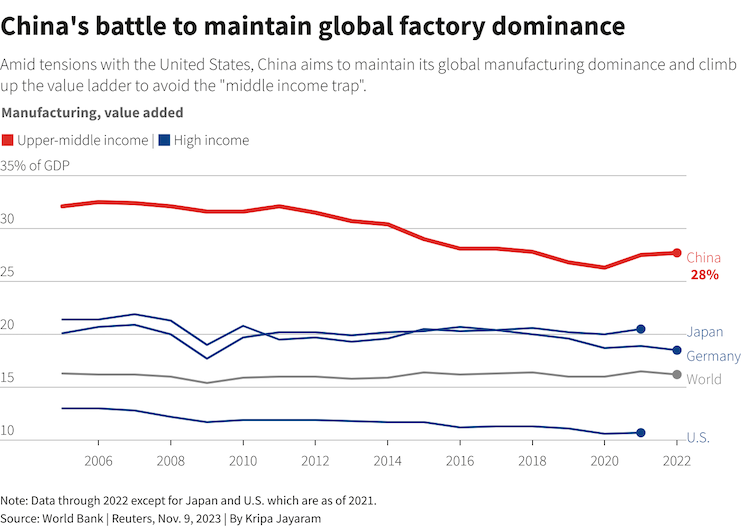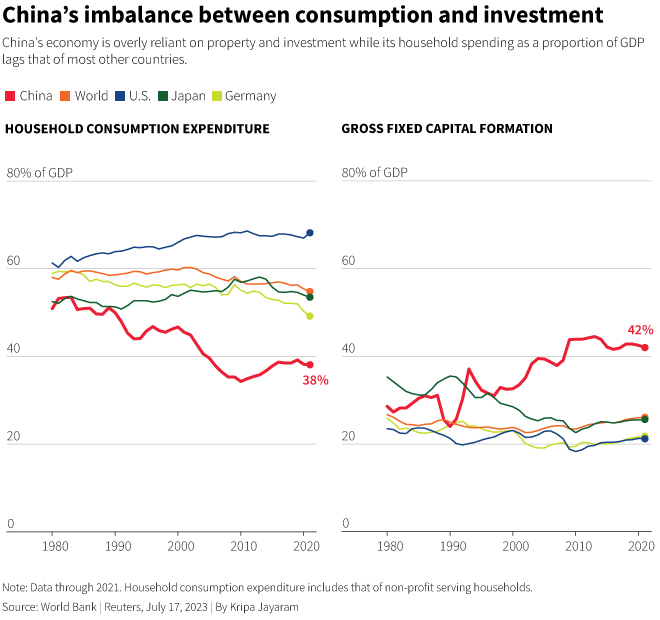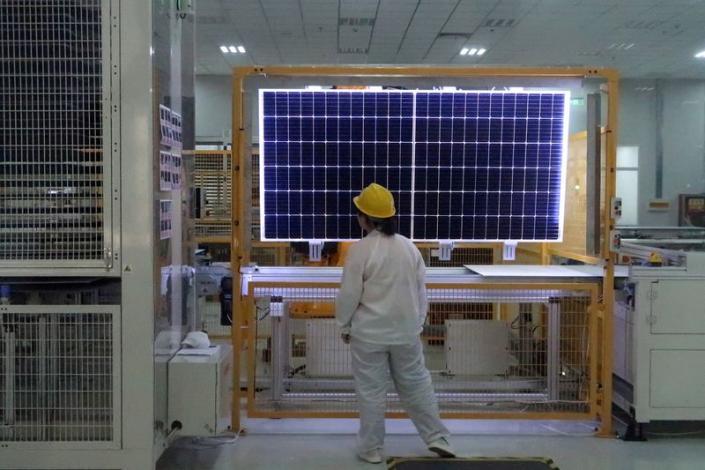Moves by China to upgrade its manufacturing by directing investment toward the production of high-tech goods such as chips and electric vehicles has led to fears of a new wave of cheap exports.
Lending data from China’s central bank shows that up to the end of September lending to the manufacturing sector jumped by 38%, while loans to the troubled property sector fell 0.2% year-on-year.
Economists caution that this wave of investment differs in key respects from an earlier capital investment surge that, among other effects, inflated China’s solar panel industry, triggered a trade fight and put scores of companies out of business.
The trend has alarmed some key trading partners, particularly in Europe where an investigation into Chinese EV subsidies is underway.
ALSO SEE: Chinese Chipmaker Sues Micron For Alleged Patent Infringements
‘Overcapacity being pushed out to the world’
“There is lower consumption in China right now but you have massive overcapacity that is being pushed out to the world, including in batteries, solar and chemicals,” Jens Eskelund, president of the European Chamber of Commerce in Beijing, said.
“Europe and China are like two trains that are going to collide,” Eskelund said, referring to trade.
China’s industrial policy will be on the agenda at this week’s meeting of the Asia Pacific Economic Cooperation (APEC) forum in San Francisco, where Chinese President Xi Jinping is expected to meet US President Joe Biden.
Under Xi, China has sought to make itself an advanced manufacturing powerhouse for high-end goods for the world, including EVs, wind turbines, aerospace components and advanced semiconductors.
Critics say the push has come at the expense of another need – to get China to consume more and export less, a structural shift many economists see as key to preserving high levels of growth.

Focus on advanced sectors
Policymakers have struggled with overcapacity before. Stimulus following the 2007-08 global financial crisis triggered a boom in steel, solar and other areas, but also generated growth that ultimately helped absorb much of that new production, Frederic Neumann, chief Asia economist at HSBC, said.
This time, the government’s focus is narrower, targeting high-tech and “advanced manufacturing”, a goal laid out in 2021 in the 14th five-year plan.
“China has adopted a strategy to shift investment spending from the real estate sector into manufacturing, which will drive up capacity further. Rather than boosting goods absorption via surging construction, China is opting to drive up the capacity of goods-producing industries,” Neumann said.
“Global markets, unfortunately, are not in a position to absorb the additional capacity.”
But there is another difference from previous episodes of overcapacity: the sums are smaller.
The headline growth rate for financing into manufacturing is likely close to 18%, said Tao Wang, chief China economist at UBS, because the other major source of financing for companies – bonds – is down sharply, meaning a more modest combined increase.
And overall investment growth in Chinese manufacturing has been slowing as producers respond to a weak market.
“Orders and profits are down and they tend to react to that,” Wang said.
Still, investment in high-tech manufacturing outpaces the rest of the sector. It grew 11.3% in the first nine months of 2023 year-on-year, compared with 6.3% for overall manufacturing investment, according to data from China’s National Bureau of Statistics.

Green development, strategic industries
A review of more than 100 publicly available policy documents and state media reports found that dozens of provincial and municipal governments are increasing the proportion of government loans directed to green development, advanced manufacturing and strategic industries.
For example, Guangdong province has increased lending to both high-tech and advanced manufacturing by about 45%, state media reported. During the first half of 2023, outstanding loans to the high-tech manufacturing sector in the eastern province of Shandong jumped 67%.
By the end of September, Dongguan, a southern manufacturing city of 7.5 million people, had a total outstanding loan balance to high-tech companies of 246 billion yuan ($33.7 billion), about a fifth of its economy.
Signs of excess capacity are appearing. Forecasts indicate China will soon be able to meet all global demand for lithium-ion batteries, said Duo Fu, vice president of Rystad Energy.
Similarly, its automakers, including EV producers, had the capacity to produce 43 million cars a year at the end of 2022, with plants operating at just 54.5% capacity, China Passenger Car Association (CPCA) data show.
Unfortunately, sluggish economic growth and stunted consumption limits what can be purchased domestically.
After decades of prioritising supply, household consumption accounted for only 38% of gross domestic product in 2021 – even before the harshest Covid lockdowns – compared with 68% for the US and 55% the world average, World Bank data showed.

In some ways, the race to invest in advanced sectors is helpful for China, Lu Zhengwei, chief economist at Industrial Bank in Shanghai, said.
“Generally speaking, I think the investment in the new sectors is healthy and will support the sectors’ long-term development. They are investing while seeing overcapacity, which drives technological development.”
For the global economy, Chinese production could help curb inflation.
“Far from losing global export market shares, Chinese produces may gain competitiveness,” Neumann said. “In turn, this could raise disinflationary pressures in global goods markets, helping to curtail inflation.”
Neither point will mitigate trade tensions, particularly as many countries push plans to favour domestic high-tech industries.
“Over the long-term, we need to have an adjustment process,” a Chinese government trade adviser said, speaking on condition of anonymity.
“We should let market forces eliminate some firms.”
- Reuters with additional editing by Jim Pollard
ALSO SEE:
China to ‘Dominate’ Global Solar Supply Chain For Next Decade
China to Scrutinise Rare Earth Outflows as Exports Rise
Europe Assessing Tariffs on Chinese EVs Amid Subsidy Concerns
China Warns of Export Curb on Polysilicon, Solar Wafers
China Goods Ban to Spur Big Drop in US Solar Installations





















